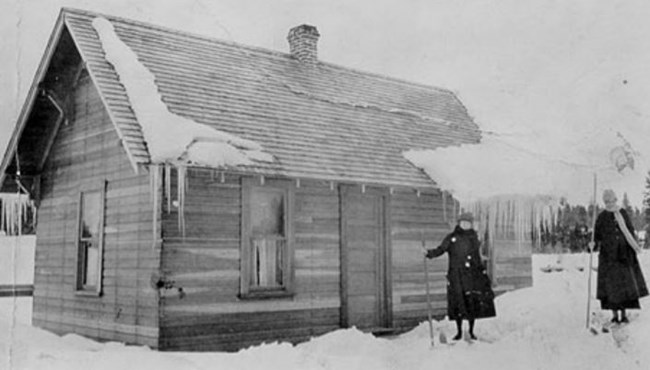Last updated: May 19, 2021
Article
Log Cabins in America: The Finnish Experience (Teaching with Historic Places)

Log cabins are as American as Fourth of July fireworks, baseball, and the bald eagle. Think of a pioneer and chances are you think of a log cabin: could Daniel Boone or Davy Crockett have lived in any other kind of house? Can you imagine the 1840 election--"Tippecanoe and Tyler, Too!"--without remembering the log-cabin-and-cider campaign? Would we be so impressed with Abe Lincoln if he had learned his letters under a crystal chandelier in a brick, Georgian-style house? Is it conceivable that Laura Ingalls Wilder's little house on the prairie was anything but a snug log structure? Assuredly, log cabins are enmeshed in American history, folklore, and myth. Use this lesson plan to learn more about the role of log cabins in American history and culture. (Click on the image for the full lesson plan.)
Essential Question
What skills and materials do you need to build a log cabin?
Objective
1. To explain the distinctive features of log structures built by Finnish homesteaders in Idaho.
2. To explain how Finns and Swedes influenced the techniques used for building log structures.
3. To describe how the log cabin became so widely used among colonists and later pioneers.
4. To investigate the student's own locality to find out what kind of folk housing was prevalent in their own community.
Background
Time Period: 1700s-1900s
Topics: This lesson could be used in teaching units on the development of the early colonies, trans-Appalachian settlement, or late 19th- and early 20th-century immigration.
Grade level
Middle School: Sixth Grade through Eighth Grade
Subject
Literacy and Language Arts,Social Studies
Lesson Duration
90 Minutes
Common Core
6-8.RH.2, 6-8.RH.3, 6-8.RH.4, 6-8.RH.5, 6-8.RH.6, 6-8.RH.7, 6-8.RH.8, 6-8.RH.9, 6-8.RH.10, 9-10.RH.1, 9-10.RH.2, 9-10.RH.3, 9-10.RH.4, 9-10.RH.5, 9-10.RH.6, 9-10.RH.7, 9-10.RH.8, 9-10.RH.9, 9-10.RH.10
